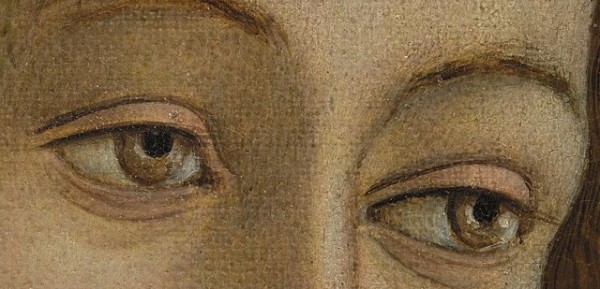
What is reading? To me it’s a noisemaker. Reading—I mean silent reading—sets off sounds, the sounds within words and the sound of words. If I can’t pronounce a word, I can’t read it either. It stops me. I read of course with my eyes. My eyes give me words as sounds. It’s as if the book were reading itself to me in my voice.
So, how do eyes read? They herky-jerk along like a cart on a bumpy road. They halt four or five times per second to take in a word or two, an eye motion called saccades (sak-ODDs). Only the fovea, at the center of our retina, can focus with enough resolution to see letters. As Jessica Love writes in the Spring issue of The American Scholar (“Reading Fast and Slow”), these “fixations,” as psychologists call what happens when our eyes land on the next set of words, take in about “four letters to the left of our fixation point and some 15 letters to the right.” We tend toward the right, Love elucidates, because English runs from left to right and we care where we’re going more than where we’ve been.
I’m currently reading Alberto Manguel’s A History of Reading. Manguel passed his childhood buried in a book, first in Israel and then back in Argentina. His book on reading books evokes dusty bookshops, infinite in the worlds they contained. Reading began 6,000 years ago with writing—scratchings by Sumerians on clay tablets. But actually, Manguel writes, reading began before writing began. You can read animal tracks, the sky, your lover’s face. All are signs, all signify. Tracking one’s dinner through the forest (hoofprints = deer = dinner) may be ancestral to tracking a series of marks shaped RED on the page and seeing fire or rubies or blood.
So how does the brain read? Reading involves language and so requires our brain’s Broca’s area, essential for articulating words, and its Wernicke’s area, essential for speech comprehension. But the reading brain is doing something more. Object recognition, according to Stanislas Dehaene in Reading in the Brain, is part of it. An alphabetic letter is a type of object. A word is a related type of object. Alphabetic letters in all languages mirror circles and angles and crossroads analogous to the edges of objects in the physical world. In this sense, reading is a coherent outcome of our past as hunters and gatherers.
Still, it’s pretty remarkable that strings of letters give us sounds that mean Chekhov or chocolate or artichoke. And strings of letters give us visions—that elephant in the garden. And they can make us laugh or cry.
One type of brain injury results in a sudden and total inability to read. Speaking and comprehending speech remain intact. What has been damaged is a patch of the left lateral sulcus, a deep fold that lies between the occipital (visual) lobe in the back and the temporal lobe, located immediately behind the ear. This, according to Dehaene, is the brain’s “letter box.” It’s the area that identifies the visual form of letters (graphemes) and transmits them to areas that compute language sounds (phonemes) and meanings. Or it may be that the sight of a word sets off phonological mapping in the frontal lobes. So writes Maryanne Wolf (Proust and the Squid: The Story and Science of the Reading Brain).
Expert readers tend to keep their reading moxie in the left hemisphere. People with dyslexia—some of whom are quite brilliant in visual and spatial terms—tend to process reading in the right hemisphere. Learning to read is a laborious process, as expert readers tend to forget, its essence being to associate graphemes with their corresponding phonemes, then to sound out a word, and then to associate that word with a meaning. Both Wolf and Dehaene passionately advocate the phonetic system of teaching reading (practicing putting letters with sounds) as being aligned with what the brain does when it reads.
But what about reading minds? I can’t read your mind. I don’t even know who you are. But then again, I can read your mind. Right this minute, you are reading these words. You are reading them in your own voice. And in reading these words you are reading my mind.


